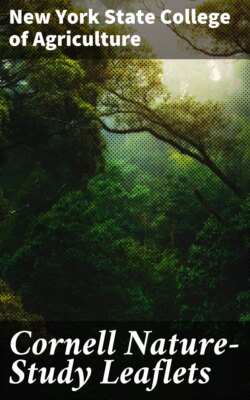Читать книгу Cornell Nature-Study Leaflets - New York State College of Agriculture - Страница 20
На сайте Литреса книга снята с продажи.
Fifth Grade.
ОглавлениеFall work.—Study the Bees and Ants.
Fit up ants' nests. Insect Life, p. 278.
Teach the whole life-history by allowing the pupils to colonize the nests. Manual for Study of Insects, pp. 633-639; Insect Life, p. 271. Make observations upon the eggs, pupæ, workers, males, females. What are the winged forms that appear in swarms in June and July.
Let the pupils observe the relation of ants to aphids. This may be done on almost any shrub or roadside plant. Home Nature-Study Lesson 1904, No. 8.
The teacher should read Sir John Lubbock's "Ants, Bees and Wasps."
Many stories on these subjects may be told and read, especially those concerning the habits of exotic ants and ant wars which the children are not likely to see; also of the slave-making ants. These slave-making ants are quite common in New York State; their nests may be found under stones. They resemble the brown mound-builder ant; the slaves are black.
Spring work.—In the spring work in this grade, study the habits of the honey bee. An observation hive is desirable but not necessary. Bring in the honeycomb filled with honey. If there are apiarists in your neighborhood, they will gladly give you specimens of brood in the comb. Read The Bee People and the Manual for Study of Insects, p. 673.
Develop all the facts of the wonderful life in the hive by letting the pupils observe them as far as possible. Then give them the many interesting stories:
Story of the Workers.
Story of the Queen.
Story of the Drone.
Story of the Bee Larva.
Story of Honey Making.
Story of Wax and Comb Making.
Story of the Swarm.
In connection with the study of the honey bee, study the bumble bee. Manual for Study of Insects, pp. 672-673; Insect Life, p. 256. Begin with the study of the big queen that appears in May or June. Show that she is of great benefit to us and must not be harmed or frightened. Let the bumble bee's nest be a problem for summer observation, and finish the study in the next grade in the fall.
Summary of objects and methods.—The work of this year should have for its objects the harmonious life of social insects; their unselfish work for each other; their devotion to their respective colonies; their ways of building and of defending their habitations.
The work should be based upon observations made by the pupils in and out of the schoolroom. Many lessons should be given, mostly in the form of stories. Ways of the Six-Footed, pp. 55-94.
